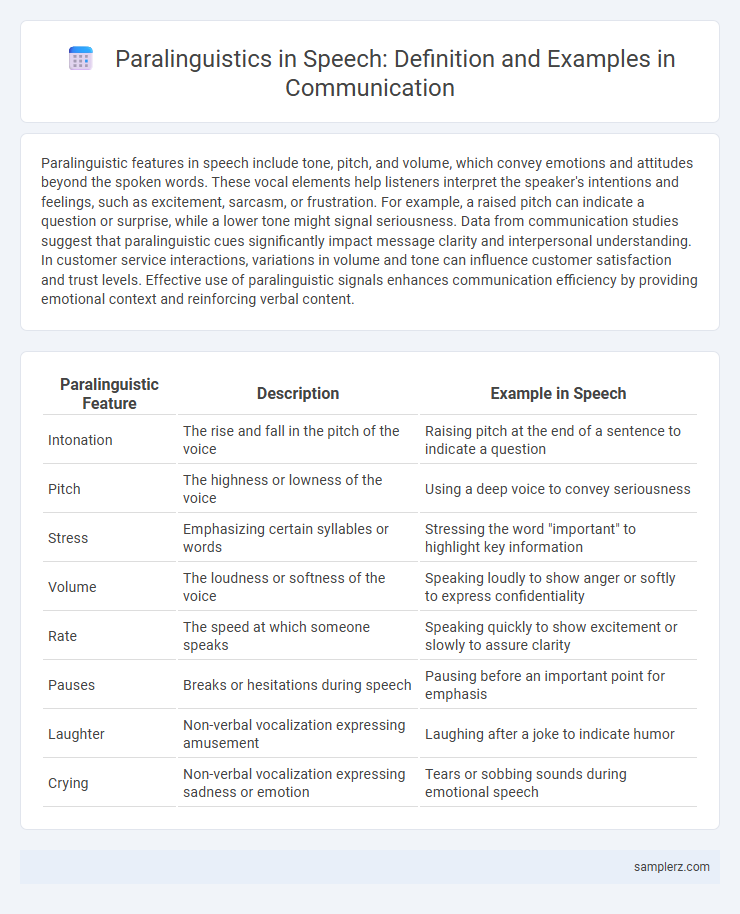Paralinguistic features in speech include tone, pitch, and volume, which convey emotions and attitudes beyond the spoken words. These vocal elements help listeners interpret the speaker's intentions and feelings, such as excitement, sarcasm, or frustration. For example, a raised pitch can indicate a question or surprise, while a lower tone might signal seriousness. Data from communication studies suggest that paralinguistic cues significantly impact message clarity and interpersonal understanding. In customer service interactions, variations in volume and tone can influence customer satisfaction and trust levels. Effective use of paralinguistic signals enhances communication efficiency by providing emotional context and reinforcing verbal content.
Table of Comparison
| Paralinguistic Feature | Description | Example in Speech |
|---|---|---|
| Intonation | The rise and fall in the pitch of the voice | Raising pitch at the end of a sentence to indicate a question |
| Pitch | The highness or lowness of the voice | Using a deep voice to convey seriousness |
| Stress | Emphasizing certain syllables or words | Stressing the word "important" to highlight key information |
| Volume | The loudness or softness of the voice | Speaking loudly to show anger or softly to express confidentiality |
| Rate | The speed at which someone speaks | Speaking quickly to show excitement or slowly to assure clarity |
| Pauses | Breaks or hesitations during speech | Pausing before an important point for emphasis |
| Laughter | Non-verbal vocalization expressing amusement | Laughing after a joke to indicate humor |
| Crying | Non-verbal vocalization expressing sadness or emotion | Tears or sobbing sounds during emotional speech |
Introduction to Paralinguistics in Speech
Paralinguistics in speech includes vocal elements such as tone, pitch, volume, and speech rate that convey meaning beyond words. For example, a rising intonation can indicate a question, while variations in loudness may express emotions like anger or excitement. These vocal cues enhance communication by providing context and emotional depth in conversations.
The Role of Tone in Verbal Communication
Tone plays a crucial role in verbal communication by conveying emotions and attitudes beyond the literal meaning of words. Variations in pitch, volume, and speed can express sarcasm, urgency, or sincerity, influencing how messages are interpreted. Understanding paralinguistic cues like tone enhances clarity and fosters effective interpersonal interactions.
Facial Expressions as Paralinguistic Cues
Facial expressions serve as powerful paralinguistic cues that convey emotions and intentions beyond spoken words, such as a smile indicating friendliness or raised eyebrows signaling surprise. These nonverbal signals enhance communication by providing context and emotional depth, often influencing the listener's interpretation of the message. Research shows that facial expressions can account for up to 55% of communicative meaning, making them critical in effective interpersonal interactions.
Importance of Speech Rate and Pauses
Speech rate and strategic pauses significantly influence communication effectiveness by regulating information processing and emotional impact. A moderate speech rate enhances listener comprehension and retention, while well-timed pauses allow for emphasis and give the audience time to reflect. Variations in these paralinguistic elements can convey confidence, urgency, or hesitation, shaping the overall message delivery.
Volume and Its Impact on Message Delivery
Volume in speech serves as a critical paralinguistic cue that significantly affects message delivery by emphasizing emotions such as urgency or calmness. Variations in loudness can alter the listener's perception, making a message appear more confident and persuasive or, conversely, hesitant and uncertain. Controlling volume strategically enhances clarity and engagement, ensuring that the intended emotional tone and importance of the message are effectively communicated.
Pitch Variation in Expressing Emotions
Pitch variation plays a crucial role in communication by conveying emotions such as excitement, anger, or sadness through changes in voice frequency. For example, a higher pitch often expresses happiness or surprise, while a lower pitch may indicate seriousness or frustration. This paralinguistic element enhances message clarity and emotional depth beyond the spoken words.
Stress and Emphasis in Spoken Language
Stress and emphasis in spoken language serve as key paralinguistic features that alter the meaning and emotional tone of speech. By varying pitch, loudness, and duration on specific words, speakers highlight important information and convey intentions beyond literal words. These vocal cues guide listeners' understanding and influence the perceived urgency, confidence, or significance of the message.
Gestures Accompanying Speech
Gestures accompanying speech, such as hand movements, head nods, and facial expressions, play a crucial role in enhancing verbal communication by adding emotional depth and clarifying meaning. For example, a speaker might use a thumbs-up gesture to indicate approval or a clenched fist to convey determination, which supports the spoken message. These paralinguistic cues help listeners better interpret intent and maintain engagement during conversations.
Laughter and Sighs: Nonverbal Vocalizations
Laughter and sighs serve as powerful paralinguistic cues that convey emotions beyond spoken words, influencing the interpretation of communication. Laughter often signals amusement, agreement, or social bonding, while sighs can indicate relief, frustration, or sadness, adding depth to verbal interactions. These nonverbal vocalizations play a crucial role in expressing attitudes and emotional states, enhancing the overall meaning in face-to-face communication.
Paralinguistic Differences Across Cultures
Paralinguistic features such as intonation, pitch, and speech rate vary significantly across cultures, influencing how messages are interpreted in communication. For instance, a high-pitched tone can signal excitement in Japanese culture but may indicate nervousness in American English contexts. Understanding these paralinguistic differences is crucial for effective cross-cultural communication and avoiding misunderstandings.

example of paralinguistic in speech Infographic
 samplerz.com
samplerz.com